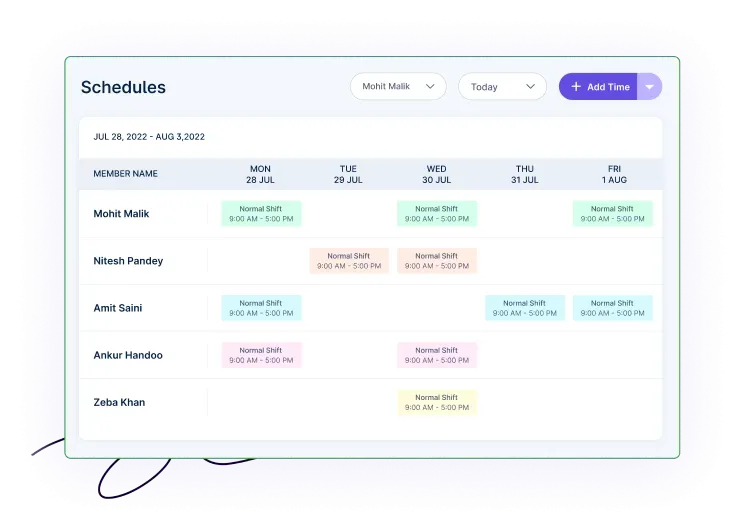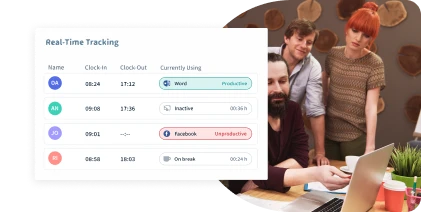Table of Contents
Companies are constantly exploring innovative ways to improve the following:
- Employee productivity
- Work-life balance
- Employee satisfaction
One such approach gaining popularity is the 9/80 work schedule.
While the traditional 9-to-5 work schedule has been the norm for decades, the 9/80 work schedule offers a refreshing alternative that appeals to both employees and employers.
However, like any work schedule, it has its own advantages and disadvantages that must be considered.
Join us as we uncover the world of the 9/80 work schedule, exploring the possibilities it holds and the considerations it demands.
Let’s dive in:
How do you define a 9/80 work schedule?
A 9/80 work schedule is a new work arrangement where employees work longer hours over a nine-day period to gain an additional day off every other week.
Rather than strictly adhering to 40-hour workweeks, the 9/80 work schedule divides 80 work hours over a two-week period.
This arrangement allows team members to enjoy a day off during each cycle.
During the first week, team members work four days of 9 hours and one day of 8 hours.
In the subsequent week, they work four 9-hour days and are rewarded with a three-day weekend.
It allows employees to enjoy work-life balance while maintaining productivity and meeting work commitments.
Will the 9/80 schedule work for my team?
The 9/80 work schedule is most suitable for industries that rely on knowledge-based work, such as:
This schedule is particularly effective for roles that do not require direct customer interaction, as it emphasizes independent contributions and output-driven work.
Employers opt for the 9/80 work schedule based on various factors, including the specific industry, operational requirements, and other considerations.
Companies such as BAE Systems, Chevron, Twitter, Calibre, and more have already implemented the 9/80 work schedule to foster a flexible work environment that benefits their employees.
A Sample of the 9/80 workweek schedule
To establish a 9/80 workweek schedule, thorough planning, and effective communication are crucial.
It is essential to coordinate vacation days carefully, paid time off (PTO), and sick leave to ensure that unexpected absences do not hinder the team’s progress.
Here’s an example of a 9/80 workweek schedule:

In Week 1, employees will work four nine-hour days and an eight-hour shift on Friday for 44 hours.
The next week they’ll work for four nine-hour days for 36 hours. And they’ll receive an extra day off on Friday.
Week 1: 44 hours
Week 2: 36 hours
Total: 80 hours
A variant of a 9/80 work schedule lets team members work eight 9-hour days consistently. Instead of having one 8-hour day and one day off, an alternative option is available where employees can opt to work two 4-hour Fridays.
Download free: Template for 9/80 work schedule
To assist you in implementing a 9/80 work schedule in your company, we have developed a complimentary Excel template specifically designed for this purpose.
This template can be easily customized to align with the unique requirements of your business.
You can download or explore the template below.
Download: Excel Google Sheets
Using Workstatus 9/80 work schedule template
Begin utilizing our 9/80 shift schedule template by using the provided template and hours as a starting point.
From there, you can personalize the employee scheduling template to align with your business’s specific 9/80 shift scheduling requirements.
Name the columns as days of the week-
- Monday
- Tuesday
- Wednesday
- Thursday
- Friday
- Saturday
- Sunday
Don’t miss to add sufficient rows for all your team members.
The incorporated formula in the template automatically calculates the hours, ensuring accurate allocation of your scheduled time.
After finalizing your schedule, save it and create a copy. It will enable you to generate schedules whenever the need arises swiftly.
A work schedule template and manually inputting hours may suffice for a new business or a small team.
However, as your team expands, you may discover that automating this process becomes more convenient and efficient.
Looking for an automated solution for your company?
A software system with automated scheduling capabilities is a great choice to start.
Pros of a 9/80 work schedule
Here are the major benefits of a 9/80 work schedule:
Improved Work-Life Balance
The compressed workweek structure of the 9/80 schedule promotes a better work-life balance.
Having an additional day off regularly enables employees to manage personal commitments, spend quality time with family and friends, pursue hobbies, or simply recharge, resulting in increased satisfaction.
Increased Productivity
The longer workdays in the 9/80 schedule can lead to enhanced productivity.
With extended, uninterrupted periods, employees can focus on essential tasks, complete projects, and experience fewer distractions.
This condensed schedule can boost efficiency and concentration, resulting in higher output levels.
Flexibility and Employee Satisfaction
The flexibility offered by the 9/80 work schedule is often highly valued by employees.
It lets them tailor their work hours to personal needs, such as appointments, errands, or other obligations.
This increased autonomy and control over their schedule can boost employee satisfaction and engagement.
Attractive Recruitment and Retention Tool
Implementing a 9/80 work schedule can make your organization more appealing to job seekers, demonstrating a commitment to work-life balance and employee well-being.
It can also contribute to higher employee retention rates, as employees appreciate the flexibility and benefits associated with this schedule.
Cons of a 9/80 work schedule
Here are some disadvantages of a 9/80 work schedule:
Longer Workdays
The longer workdays in the 9/80 schedule, typically lasting nine hours, may be challenging for some employees.
Sustaining focus and energy throughout extended periods can lead to fatigue and decreased productivity toward the end of the workday.
Difficulty in Schedule Coordination
Coordinating schedules within teams or departments can become more complex with the 9/80 arrangement.
Ensuring adequate coverage and effective communication can be challenging, especially when employees have different day-off schedules.
Employee Resistance
Introducing a new work schedule requires an adjustment period for employees to adapt to the longer workdays and the alternating day-off pattern.
Some employees may initially resist the change, expressing concerns about work-life balance or adjusting personal commitments to the new schedule.
Using Workstatus for Automated Scheduling

Workstatus offers an employee scheduling software solution that facilitates tracking employee hours and implementing a 9/80 work schedule.
You can create customized shift schedules and monitor employee hours in real time, providing visibility into individual team members’ tasks and their respective durations.
While the traditional 40-hour workweek has long been the norm, the modern workforce’s needs are evolving rapidly. The 9/80 work schedule addresses these evolving needs by offering flexibility to employees.
With proper planning, you can successfully introduce a 9/80 work schedule that suits your company and your employees.
Workstatus’s employee scheduling software enables managers to do the following:
- Generate schedules
- Assign shifts
- Track billable hours
- Simplify payroll management
It eliminates the need to create scheduling templates from scratch.
Additionally, employees can access a dashboard to track their work hours.
These features promote enhanced employee productivity, streamlined human resources management, and reduced project costs.
FAQs
Q: How does the 9/80 work schedule differ from a traditional 40-hour workweek?
Ans: The 9/80 work schedule condenses the standard 40-hour workweek into eight nine-hour workdays and one eight-hour workday, allowing for an extra day off every other week.
Q: Can all industries implement the 9/80 work schedule?
Ans: The 9/80 schedule is more suitable for knowledge-based industries, such as software development and graphic design, but it can be adapted to various sectors.
However, industries requiring round-the-clock operations may find it challenging to implement.
Q: What are the potential drawbacks of the 9/80 work schedule?
Ans: Some potential challenges of the 9/80 schedule include longer workdays, coordination difficulties, and resistance to change.
It may also be less compatible with customer-facing roles and industries with strict operational demands.









